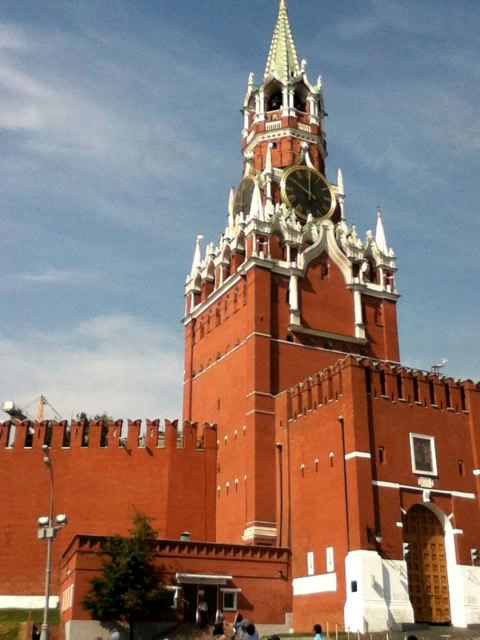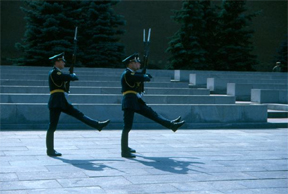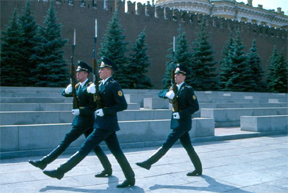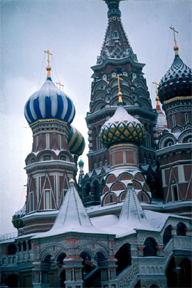| Home | About | Books | Appearances | Awards & Raves | Contact |
 |
|||||
IN LOVE WITH THE USSR – HOW DID IT HAPPEN?By Jeri Chase Ferris |
||
I have no Russians in my family. My husband, Tom, had no Russians in his family. We had never been to the Soviet Union, but we had certainly heard what it was like! And it wasn’t good.
|
||
But there we were, Tom and Jeri, standing in Red Square, Moscow, in the very heart of the evil empire. It was midnight on Christmas Eve, 1969. Soft, thick snow fell gently past the haloes of light illuminating Red Square. Cobblestones gleamed where gusts of wind had blown the snow clear. At the far end of the Square, to our left, stood St. Basil’s Cathedral with its brilliantly-colored, fantastic cupolas. Behind us stretched GUM (rhymes with doom), the massive department store which holds down one long side of the Square (actually a long rectangle). In front of us – Lenin’s Tomb, dark red, low to the ground, seemed almost to pulse with hostility toward the two Americans it faced. Two soldiers stood at attention, one on each side of the entrance, their rifles upright. They stared straight ahead, heedless of the cold and snow. The Square was nearly empty. Soviet citizens were home in bed, resting for the next day’s work. “Our” Christmas, of course, had no significance here. So we stood alone in the blowing snow, gazing at the long red wall behind Lenin’s Tomb. That wall is one of the three enclosing the Kremlin in a sort-of triangle. Inside the walls, at the top of the Parliament building, an illuminated red Soviet flag with gold-color hammer and sickle, blew in the breeze. Red. A significant word. In Russian, it is “krasny,” which means both the color red and the concept of beauty. So Red Square, Krasnaya Ploshchad, means both red and beautiful, and it truly is both. |
|
|
The bells in Spassky Tower, the tall red brick structure that anchors the far left corner of the red brick Kremlin wall, began pealing. As the notes ran down the scale, the gate at the base of the tower swung open. There, in the distance, we saw two Soviet soldiers emerge, swinging toward us, toward Lenin’s Tomb, in a slow, measured goose-step. Their commanding officer marched a pace behind. Then the great clock bell in the tower began striking midnight, heavy and deep and slow, as the soldiers goose-stepped in solemn time. At the final stroke they reached the front of the tomb and stopped at attention. The two soldiers standing on guard saluted. The two replacements saluted. They wheeled and exchanged places briskly, silently. The officer in charge shouted commands and each soldier leaving duty raised his left leg slowly, up to a perfect right angle with his body, lowered it slowly, and began the stiff goose-step back to the Spassky gate, shiny black boots up, down, arms swinging, in absolute silence.
|
||
 |
 |
My next book, SURROUNDED, is set in 1941 Leningrad, USSR, during WWII. It’s based on the real life survival story of a dear friend who lived through the Siege of Leningrad, which began when he was ten years old. The city was surrounded by the Nazis for almost three years. There was no heat, no light, no running water, and finally, no food. One million people died during that siege. You might think this is a pretty grim story – and it is – but it’s also filled with laughter and love and hope. How does Yuri survive? Read SURROUNDED and find out. I not only write about Russia, My husband and I have been to Russia many times and have collected thousands of objects which might otherwise have disappeared, objects that express the spirit and achievement of Soviet society. Recently we donated them all to be used for academic research and guess what? There's now a Ferris Russian Collection which has been called "unmatched in the western world”! You can visit the Ferris Collection to learn more, but you really need to go to Los Angeles to see all the 8,000 items, as the website has just gotten started.
|
|
||
 |
||
| Spassky Tower |
|
|
 |
 |
 |
|
|
|
|
|
|
|
|
|
February 4, 2014 – Russian exhibit at Chapman University, Orange CA, In 1970 an American high school teacher began a thirty-year journey into Stalin’s Russia. The items you see here were selected from more than 8,000 artifacts conserved on that journey. Tom Ferris (the teacher) began collecting early, and he collected just about everything. But in 1970 Tom found a focus for his collecting and a new love and passion – Russia herself. He was teaching Russian Studies at Beverly Hills H.S. when he and a fellow teacher took their students on a winter-vacation field trip to the Soviet Union. It changed Tom’s life, and mine, forever. The moment we stepped on to Russian soil a magnetic, almost spiritual, attraction pulled us into Mother Russia. Our first night in Moscow, in softly falling snow, we stood at Lenin’s Tomb in Red Square at midnight, listening to the pealing bells from Spassky Tower and the slow, measured, goose-step march of the soldiers as the clock tolled twelve. It was a moment in which one’s heart simply stopped at the unbearable beauty and agony of this country. In the 1970s antique shops and used bookstores in Moscow and Leningrad were filled with historic items. Tom began to focus his collecting on the Stalin era and reign of terror. By finding, buying, and carrying to the U.S. every scrap of 1930-40-50s material for sale on/about/by Stalin, Tom hoped to create a collection before this material disappeared into, well, history. He bought bronzes, busts, parade banners, boxes of propaganda training posters, books and posters and paintings praising Stalin. Word spread in Moscow and Leningrad that a tall American in a beaver fur coat was looking for anything related to the Stalin era, and people began to approach him – citizens who could no longer keep their busts of Stalin; their recordings of Stalin’s speeches; their books of Stalin’s writings. Armed with rubles, dollars and hand-drawn maps, and avoiding Intourist, Tom would go out at night to people’s apartments and return with bags and parcels, those precious possessions their owners wanted preserved. They were often sad and bittersweet acquisitions. “Without our history we are not a people,” said one of his sources. But Tom would save that history. Tom’s dream was that his collection of Russian memorabilia be preserved, kept safe, and made available for study so people could understand how Stalin came to be; so Soviet history would be real, not abstract; so future generations would appreciate the history and sacrifices of Soviet citizens. “Stalin’s Russia” at Chapman University is helping achieve exactly that.
|
||
All contents © Jeri Chase Ferris
|
||



